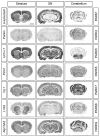Parkinson's disease: Exit toxins, enter genetics
- PMID: 19925845
- PMCID: PMC4155944
- DOI: 10.1016/j.pneurobio.2009.11.001
Parkinson's disease: Exit toxins, enter genetics
Abstract
Parkinson's disease was long considered a non-hereditary disorder. Despite extensive research trying to find environmental risk factors for the disease, genetic variants now stand out as the major causative factor. Since a number of genes have been implicated in the pathogenesis it seems likely that several molecular pathways and downstream effectors can affect the trophic support and/or the survival of dopamine neurons, subsequently leading to Parkinson's disease. The present review describes how toxin-based animal models have been valuable tools in trying to find the underlying mechanisms of disease, and how identification of disease-linked genes in humans has led to the development of new transgenic rodent models. The review also describes the current status of the most common genetic susceptibility factors for Parkinson's disease identified up to today.
Copyright 2009 Elsevier Ltd. All rights reserved.
Figures

References
-
- Abeliovich A, Schmitz Y, Farinas I, Choi-Lundberg D, Ho WH, Castillo PE, Shinsky N, Verdugo JM, Armanini M, Ryan A, Hynes M, Phillips H, Sulzer D, Rosenthal A. Mice lacking alpha-synuclein display functional deficits in the nigrostriatal dopamine system. Neuron. 2000;25:239–252. - PubMed
-
- Abou-Sleiman PM, Healy DG, Quinn N, Lees AJ, Wood NW. The role of pathogenic DJ-1 mutations in Parkinson’s disease. Ann Neurol. 2003;54:283–286. - PubMed
-
- Ahn TB, Kim SY, Kim JY, Park SS, Lee DS, Min HJ, Kim YK, Kim SE, Kim JM, Kim HJ, Cho J, Jeon BS. alpha-Synuclein gene duplication is present in sporadic Parkinson disease. Neurology. 2008;70:43–49. - PubMed
-
- Allen W. Inheritance of the shaking palsy. Arch Int Med. 1937;60:424–436.
-
- Bandopadhyay R, Kingsbury AE, Cookson MR, Reid AR, Evans IM, Hope AD, Pittman AM, Lashley T, Canet-Aviles R, Miller DW, McLendon C, Strand C, Leonard AJ, Abou-Sleiman PM, Healy DG, Ariga H, Wood NW, de Silva R, Revesz T, Hardy JA, Lees AJ. The expression of DJ-1 (PARK7) in normal human CNS and idiopathic Parkinson’s disease. Brain. 2004;127:420–430. - PubMed
Publication types
MeSH terms
Substances
Grants and funding
LinkOut - more resources
Full Text Sources
Medical

